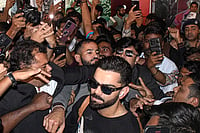Travails of Getting Educated: Students and faculty members arrange a makeshift class during the final phase of the pandemic for those who wanted to attend. The number of students dropped drastically as more children moved out of their islands in search of work

Students from various habitable islands of the Sundarbans undertake long journeys through the waterways to reach their nearest educational institution. The paucity of schools on these islands makes it difficult for students to gain educational opportunities without travelling extensively.

Struggle of Students: Sovan Roy, an ex-student of Kumirmari High School who left after class 10 during the COVID pandemic, with his battery-powered van that he drives around the island. He hopes to open a garment shop some day

Children play on the ground in front of their school.

Ram Prasad Raptan of Kumirmari Island on the day he re-registered for schooling after the lockdown was lifted. His old clothes barely fit his body as he says he didn’t have money to buy a new uniform.
Due to the various phases of lockdowns during the COVID-19 pandemic, the Indian student community had to bear a two-year-long closure of educational institutions.
While the economically privileged students from urban and semi-urban areas adapted to an online system of education, it was soon evident that the country was not equipped to take up such a challenge, even after the government’s chest thumping of “Digital India”.
The underprivileged sections of society—who needed education as a medium of socio-economic upliftment—suffered the most. As stable internet services, digital devices and data plans—that are expensive—became mandatory, a section of students belonging to the marginalised communities in rural areas was forced to migrate to urban economic zones and work as unskilled labourers. This led to the death of aspiration, people changing identities, and socio-economic exploitation. As the days passed, these poor students widened the gap of class divisions.
My photo project aims to bring these faces and spaces into the conversation. It brings out the failure of a system that is focused on the privileged sections, who are equipped with key resources. But the privileged class has been unable to provide even basic necessities to their unfortunate counterparts. Treating this phenomenon as just another normal issue, where individual dreams die, will make the future of the community regress a few generations more.
This article appeared as Poor Disconnect in Outlook’s July 21 issue Degrees of Separation, a special education issue where our reporters and columnists delved into the the business of education and its stakeholders—students, universities and education consultants.

























